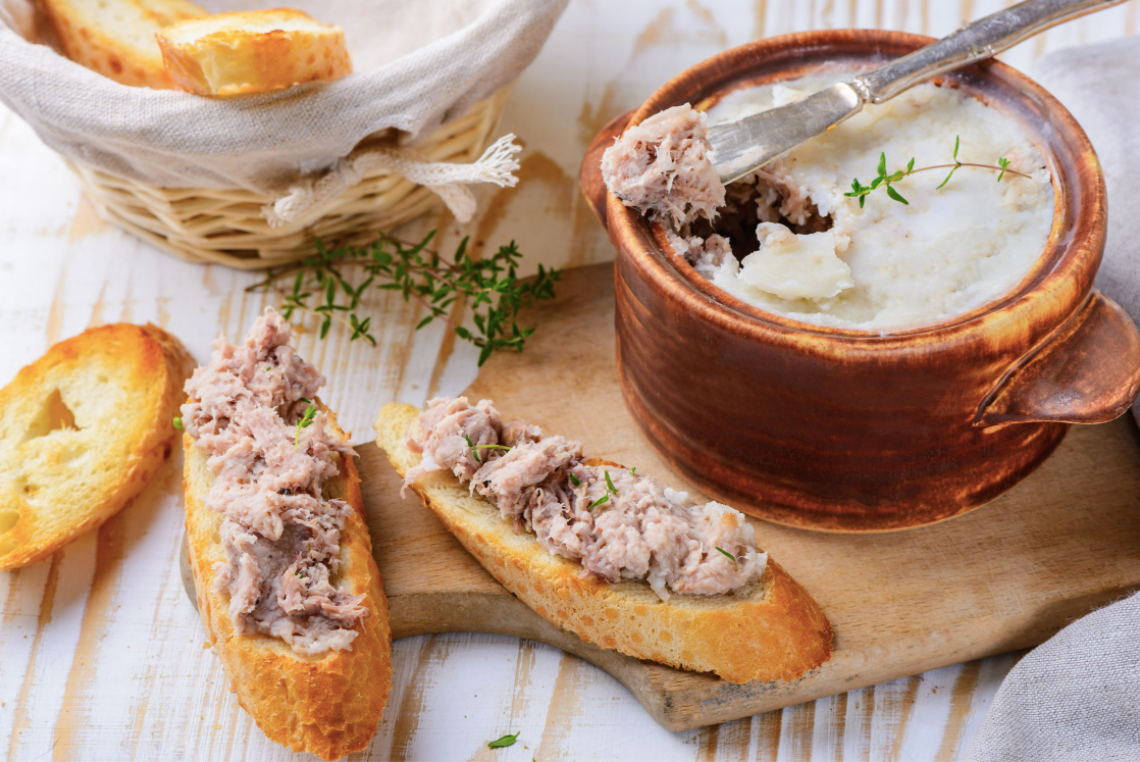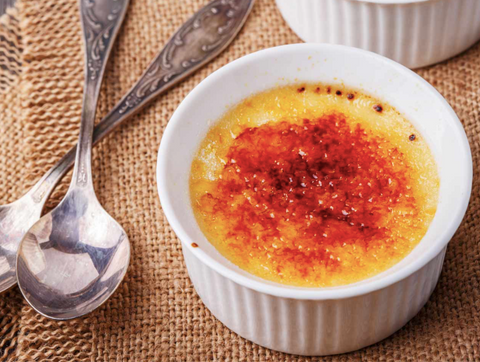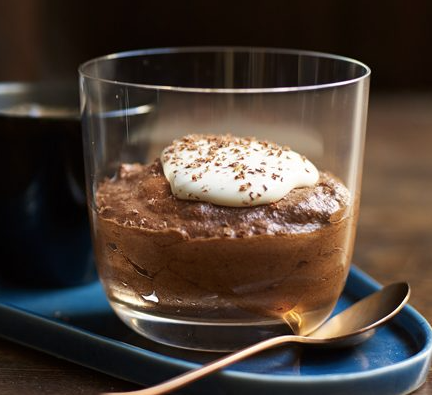It always amuses me how dishes that were once ridiculed as peasant fare are today considered gourmet and refined. Foie gras, oysters, lobster, and well-known dishes like boeuf bourguignon and coq au vin used to be considered poor people's cuisine; currently, they're only served in the most upscale restaurants and are rather costly.
Confit, a French delicacy, is another example. It was made out of necessity rather than indulgence. It requires poaching meat for an extended period in fat and seasonings, as has been done for millennia. When the fat cools, it rises to the top, hardens, and forms a protective layer of fat around the meat to keep oxygen out (which is what causes spoilage). As a result, the meat retains its freshness, extending its shelf life, and the flesh beneath it can be stored for months. In the United Kingdom, this process is known as potted meat.
Rillettes, a French delicacy akin to confit, is today's featured recipe. Pork is the most popular meat utilized, but other options include duck, geese, rabbit, poultry, and fish. Cubing the flesh, harshly seasoning it, gently cooking it in fat until fork-tender, finely cutting the meat, mixing in part of the fat to form a spreadable consistency, and then allowing it to cool with a layer of fat on top are all steps in the technique.
Rillettes will stay in the fridge for several months if properly packed (and will only become better with age), making them great for entertaining. Rillettes has long been a popular French dish; they're wonderful and one of my favorite ways to entertain. Imagine biting into fork-tender pork that has been grilled for hours in fragrant spices before being spread on crispy baguettes. It has a terrific flavor!
All about eating Rillettes!
Rillettes are chunky beef spread made with cooked and shredded beef. That may not sound appealing, but look at the ingredients and you'll see how delicious they are.
Rillettes are made with:
- Meats, such as pig and other types of meat
- Fatback, hog belly, duck fat, and/or lard are examples of fatty portions of meat
- Seasonings include salt, spices, and aromatics
- Wine, water, and/or stock are all good choices
There are many types of rillettes to eat, including:
- Pork rillettes
- Rabbit rillettes
- Duck rillettes
- Chicken rillettes
- Game meat rillettes
- Veal rillettes
- Seafood rillettes, made with salmon, trout, or sardines
- Vegan rillettes made with tofu, jack fruit, mushrooms, and other vegetables (Vegetarians aren't the main focus here, but they'll be pleased)
For the finest and most delicious outcomes, use good, pasture-raised pork. After tasting this rillettes and letting the tastes fill your lips, you'll be hooked thanks to the seasonings and high-quality fat.
Let's get the party started!
Look for a boneless pork shoulder. Choose pasture-raised pork that has been chopped into 1-inch cubes for the best quality and flavor. In a large mixing basin, place the meat.
Combine the remaining ingredients in a bowl, except the fat, and crush them into the pork with your hands until evenly distributed. Refrigerate for three days after wrapping in plastic wrap.
Remove the pork after 3 days and set it aside to chill for 30 minutes while you create the fat. Preheat the oven to 275 degrees Fahrenheit.
A word on lard: Depending on the molds you choose for your rillettes, you'll need 14-18 ounces of high-quality lard. Make sure you get it from a reputable retailer, as practically all store-bought lard contains hydrogenated fat, which you should avoid.
Make your lard from pasture-raised hogs if you want pure, clean lard with the best flavor. To be honest, yes, it is. PLUS, it's a LOT less expensive than purchasing it!! Once you have the lard, slowly melt it in a saucepan until it is liquid.
Pour the melted lard over the pig in a Dutch oven, making sure it is completely saturated. If there isn't enough fat, melt some more and combine it with the other ingredients. Drizzle it with olive oil if you run out of lard and simply need a little more to finish.
In a warm Dutch oven with the cover on, cook for 2 to 3 hours, or until the pork is fork-tender. You'll be salivating at the thought of the aroma flowing from your oven while it's boiling and after the lid is off!
Before handling it, take it out of the oven and let it cool fully. The juniper berries should be removed and discarded. Transfer the pork to a chopping board with a slotted spoon.

Skim the fat off the top of the liquid in the Dutch oven with a ladle, being careful not to scoop up any of the liquid. The fat will float on top of the liquid, clear, while the liquid underneath will be black. Scraped fat should be separated into its bowl. Any residual fat will harden as the liquid cools, allowing you to remove it. Half of the cooking liquid should be poured into a measuring cup and kept aside.
Mince the meat finely. In a large mixing bowl, combine the chopped pork, 1/3 of the residual fat, and 1/3 of the Dutch oven liquid. Combine all of the ingredients in a large mixing bowl and stir until smooth. Season to taste with a touch of salt and pepper.
Depending on your desire, place the meat in a large casserole dish or several smaller terrines. To smooth out the surface of the meat, gently press it. A chilling time of at least one hour is required.
Melt the residual lard in a pot. Over the cold rillettes, pour at least 14 inches of lard. The fat should be refrigerated until it has hardened.
Rillettes are best eaten after a few days when the flavors have melded, although they are also tasty straight away. The rillettes will keep in the fridge for at least 2 months, and much longer if they are entirely covered in fat with no air gaps.
Allow the rillettes to soften at room temperature for about an hour before serving to get a spreadable consistency. Reseal the exposed portion with a layer of fat if you're not going to eat it completely and don't plan to finish the leftovers within a few days.
Enjoy!
How do you eat rillettes?
I couldn't think of a way to eat my first batch of rillettes other than spooning them into my mouth after they'd been chilled. I did some study on rillettes and wanted to share what I learned with you. Mmmmm!
Rillettes go well with sourdough bread, crostini, baguettes, and Melba toast. Rillettes can also be used as a pasta stuffing, in open-faced sandwiches, and as a sandwich filling. You're only restricted by your imagination when it comes to non-bread rillettes.
Rillettes are about more than just checking something off your to-do list like "Get bread." If you don't want to eat bread but still want to eat rillettes, what can you do? Apart from wine, what else goes well with rillettes? If you have the same concerns, keep reading!
Most people do not eat rillettes straight from the jar because they are a substantial dish. Let's take a look at some other dishes that go well with rillettes, including starchy foods, rabbit food, other animal foods, and Korean cuisine.
Starchy foods to eat with rillettes include:
- Sourdough bread
- Crostini
- Baguettes
- Melba toast
- Sandwiches
- Open-faced sandwiches
- Artisanal bakery bread
- Wonder Bread is a sort of bread that comes in a variety of shapes and sizes (non-fancy people can also enjoy rillettes)
- Homemade cornbread slices
- Stuffed Pasta
- Any type of cracker
- Mini waffles
Vegetables to eat with rillettes include:
- Cucumbers, chopped crudité (as rillettes are too firm to dip vegetables into)
- Peppers, mini (fill them with the rillettes)
- Celery sticks (filled with rillettes to make a meaty ants-on-a-log treat) (Optional)
- Salad of mixed greens (garnish the salad with a couple of chunks of the rillettes)
Other animal products to eat with rillettes include:
- Hard cheese in cracker-size bits
- Cold sliced beef or chicken
- Crackers with cheese inside (crackers made entirely out of cheese)
Rillettes in the Korean manner can also be made with rice and kimchi. (This is how Chowhound user Ipsedixit recommends eating rillette: "I know for a fact I like it on top of rice, with some kimchi mixed in.")
You're probably not here because you eat a low-fat diet. Still, you might be concerned that rillettes will upset your stomach...
Can I still enjoy rillettes if too much fat makes me queasy?
As previously indicated, rillettes is fatty. "The fundamental proportions of rillettes are two-thirds lean-to one-third fat," James MacGuire writes in his Art of Eating piece Rillettes de Tours. Rillettes, on the other hand, combine meat and fat into a unified whole. Between the meat and the fat puddle, there is no fat puddle (except the protective layer of fat on the top of the jar of rillettes). As a result, rillettes has a rich, rather than fatty, appearance. You won't overeat it because you'll be eating it with other foods. If you have fatty food intolerance, serve your rillettes with a fresher base, such as sliced cucumber.
How to eat canned rillettes
Canned duck rillettes, like any other canned rillettes, can be eaten like non-canned rillettes. I had no idea canned rillettes existed until today! I first learned about them through a story about someone who purchased them in Paris and brought them back to the United States. You won't have to worry about running out of canned rillettes in your neighborhood because rillettes last a long time in the fridge or freezer.
Bread substitutes that taste like bread to eat with rillettes (keto, carnivore, Zero Carb)
If conventional bread doesn't agree with you or isn't part of your diet, there are various keto and animal-food alternatives to consider. Isn't life amazing? There's also a chaffle, which is cheese turned into a waffle. Although I haven't tried all of these recipes, the cheese-only chaffle, as well as the two-and-two cream cheese and egg mixture, are delicious (and crunchy).
What can I pair rillettes with?
Even if you just serve your rillettes with your favorite rillettes-delivery cuisine, having a few more dishes on the table will make them taste even better.
The following desserts pair well with rillettes:
- Any sort of jam, including fig jam
- Cranberry sauce (optional)
- Pickled fruit has been preserved in some way
Savory items that pair well with rillettes:
- To name a few, pickled onions, asparagus, and peppers
- Gherkins or pickles
- Olives are a fantastic option
- Cheese
- Seeds and nuts
- If preferred, hard-boiled eggs
Rillettes pair well with the components of a charcuterie dish. When you get home from a long day at work, you might be wondering if a rillettes plate is a sufficient lunch. Yes, I agree. This sort of plate is known as a plowman's lunch in the United Kingdom.
What kind of wine goes best with rillettes?
I don't drink wine, but I know a lot of people who do, so I thought I'd throw some wine pairings into the mix.
Pairing wine with pork rillettes:
- Pinot Noir, which, according to Elephant's Delicatessen in Portland, "has enough acid to cut through the fat of a herbaceous garlic greasy pâté." This is true of pig pâté, but it also applies to pork rillettes, in my opinion. Please accept my apologies for not knowing how to pair wines!
- According to VinePair's The Definitive Guide To Pairing Charcuterie and Wine, Sauternes, Assyrtiko, and Albario are the way to go.
Pairing wine with duck rillettes:
- Pinot Noir
- Beaujolais
- Lambrusco secco
Pairing wine with salmon rillettes:
- A Sauvignon Blanc that's not too sweet.
- Any oak-free medium- to full-bodied white wine (including effervescent). "A substantial wood impact, we observed, will make the rillettes taste incredibly fishy," writes Wine Review Online. They recommend five wines to pair with smoked salmon rillettes in their article WINE WITH…Smoked Salmon Rillettes,.
After eating rillettes, James MacGuire in the Art of Eating recommends a glass of sec or demi-sec Vouvray (a French wine made with Chenin Blanc grapes) or a dry everyday wine to cleanse your taste. While this is a post about wine and rillettes, I'd like to offer a beer recommendation. Duck rillettes should be paired with brown ale, according to Alexian Pâté and Specialty Meats in Neptune, New Jersey. Les Canardises, a Quebecois company that specializes in foie gras and confit from free-range ducks, noticed that beer and rillettes mix together so well that they decided to include beer in their rillettes. I believe that beer and beer-enhanced rillettes would be a good match. Maybe you could put that to the test and let me know what you find out!




